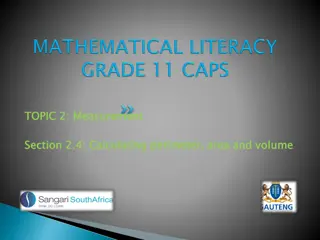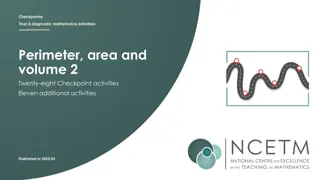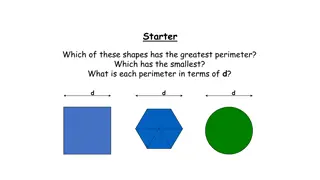Exploring Perimeter and Area in Mathematics Checkpoints for Year 7
Dive into a series of engaging activities focused on perimeter and area concepts in mathematics for Year 7 students. Discover various checkpoint tasks, additional activities, and animated solutions to enhance understanding and application of geometric principles. Explore topics such as shapes on a grid, paper cutting, strange staircases, and more to strengthen skills in calculating perimeter and area.
Download Presentation

Please find below an Image/Link to download the presentation.
The content on the website is provided AS IS for your information and personal use only. It may not be sold, licensed, or shared on other websites without obtaining consent from the author. Download presentation by click this link. If you encounter any issues during the download, it is possible that the publisher has removed the file from their server.
E N D
Presentation Transcript
Checkpoints Year 7 diagnostic mathematics activities Perimeter and area Fourteen Checkpoint activities Ten additional activities Published in 2021/22
Checkpoints 16 Checkpoint 1: Bigger? 2: Paper cutting 3: Strange staircases 4: Sticky note patterns 5: Mosaics 6: Tile changes Underpins Code 6.2.1 6.2.2 The concepts of perimeter and area This three-digit code refers to the statement of knowledge, skills and understanding in the NCETM s Sample Key Stage 3 Curriculum Framework (see notes below for more information).
Checkpoints 714 Checkpoint 7: Shapes on a grid 8: Building plots 9: Goldilocks and the three rectangles 10: Area or perimeter 11: From one vertex 12: Labels 13: Holes Underpins Code 6.2.1 6.2.2 Calculating perimeter and area 14: Dozen or doesn t? This three-digit code refers to the statement of knowledge, skills and understanding in the NCETM s Sample Key Stage 3 Curriculum Framework (see notes below for more information).
The concepts of perimeter and area Checkpoints 1 6
Checkpoint 1: Bigger? a) Which of these shapes do you think is the biggest? Why? b) Does including a square grid help? c) In what way/s is the shape you chose bigger than the others? In what way/s is it the same? * *In present mode, the square grid will appear on the image alongside this question. Can you create shapes with this same area? How many possibilities are there?
Checkpoint 2: Paper cutting a) A sheet of paper is cut in two. Which of the two pieces has the longest perimeter, A or B? Why? b) A different sheet of paper of the same size is cut in two. Which of the two pieces has the longest perimeter, C or D? Why? How would you order the four pieces of paper from shortest to longest perimeter?
Checkpoint 3: Strange staircases The perimeter of each rectangle is 26 cm. How long is the red line each time? A B C Sketch another line, joining the same corners, that is longer than the one in A. Then sketch one that is shorter and one that is the same length.
Checkpoint 3: Strange staircases (solution) The perimeter of each rectangle is 26 cm. How long is the red line each time? A B C
Checkpoint 4: Sticky note patterns Some square sticky notes are used to make a pattern of shapes. One more sticky note is added each time. E A B C D The perimeter of shape A is 4 units. The perimeter of shape B is 6 units. a) Find the perimeters of shapes C to E. b) Explain why the perimeter sometimes changes and sometimes stays the same. Predict the perimeter for shapes F and G. Continue the patterns to draw shapes F and G were you correct?
Checkpoint 5: Mosaics Marius is making mosaic patterns using these square tiles. Estimate how many tiles he will need to completely cover each different shape. Estimate how many tiles he will need for this circle. In present mode, click on each shape to reveal the tiles. Was your estimation correct?
Checkpoint 6: Tile changes On the right is a square made up of nine tiles. By adding, removing or moving tiles, can you change the shape so that: a) The area changes, but the perimeter doesn t? b) The perimeter changes, but the area doesn t? Is it always, sometimes or nevertrue that: Increasing the perimeter of a shape will increase the area of that shape? Increasing the area of a shape will increase the perimeter of that shape? Explain how you know.
Calculating perimeter and area Checkpoints 7 14
Checkpoint 7: Shapes on a grid a) How many squares of the grid below are covered by the rectangle? Explain how you know. b) How many squares of the grid below are covered by the parallelogram? Explain how you know. c) How many squares of the grid below are covered by the triangle? Explain how you know. Can you draw a different rectangle, parallelogram and triangle that will cover the same number of squares as each of these?
Checkpoint 8: Building plots Plot X Y Z Area (m2) 100 120 120 Perimeter (m) 40 242 52 Bev wants to buy a plot of land to build a house. In the table on the right is some information about the sizes of three plots. a) Which plot do you think she should choose? Below the table are the plan views of the three plots. b) Match each image to a row in the table. c) Do you want to change your answer to part a)? Why or why not? 10 m 20 m 10 m GREY 6 m BROWN 1 m GREEN 120 m Sketch another rectangular plot with the same area as X. Can you make the perimeter larger? How about smaller?
Checkpoint 9: Goldilocks and the three rectangles Goldilocks wants to work out the area and perimeter of each of these rectangles. 40 mm 40 mm 40 mm Z 13 cm 13 cm X 40 mm a) When is there too much, not enough or just the right amount of information? b) Find the area and perimeter of the rectangles where it is possible. c) Goldilocks works out the area of Z using the calculation 40 40 40 40. What has she done wrong? For the rectangle that had not enough information, the perimeter is between 41 and 44. What might the area be?
Checkpoint 10: Area or perimeter? B A D For each triangle, do you have enough information to calculate the area, the perimeter, both or neither? Explain how you know. C E F Drawn to scale. For the ones that are not possible, write the minimum additional information you need. Is there more than one way to do this?
Checkpoint 11: From one vertex Gaynor says that the area of this parallelogram is found by working out 10 6. Ollie says that the area of this parallelogram is found by working out 7.5 8. Who do you agree with? Why? Drawn to scale. Carefully draw a different parallelogram with a base of 10 cm and a perpendicular height of 6 cm. Measure the other base and perpendicular height. What is the product of these values? Why?
Checkpoint 12: Labels The three shapes are a square, a rectangle and an isosceles triangle. Choose values for the labels so that: a) Each shape has a perimeter of 12 cm. b) Each shape has a perimeter of 30 cm. c) Each shape has an area of 16 cm2. d) Each shape has an area of 25 cm2. Which boxes are never filled at the same time? Why?
Checkpoint 13: Holes a) What is the same about these shapes? What is different? 4 2 3 1 3 mm 3 mm 3 mm 3 mm 8 mm 8 mm 8 mm 8 mm 3 mm 3 mm 10 mm 10 mm 10 mm 10 mm b) c) Which shapes have the same area? Which have the same perimeter? Design another shape that has the same area and perimeter as each of your shapes.
Checkpoint 14: Dozen or doesnt? Some of these shapes have an area of 12 cm2. Some have a perimeter of 12 cm. Some have neither. Decide which shapes are in which category. G E All A angles are right angles. B D F C H Design your own shapes with an area of 12 cm2 or perimeter of 12 cm.
Additional activities Activities A J
Activity A: Shifting sticky notes Five square sticky notes are used to make a shape with a perimeter of 12 units. a) How might you move one of the sticky notes so that the perimeter stays the same? b) How might you move one of the sticky notes so that the perimeter decreases by two? c) How might you add another sticky note but not change the perimeter? How might you move one of the sticky notes so that the perimeter increases by two?
Activity B: Decorating Mia is decorating a wall in her house. It is in the shape shown on the right below, and has an area of 9 m2 . a) Which of the options below would be easiest to use to decorate the wall? Why? Wallpaper 2 m2 per roll 24 Paint 200ml covers 1.5 m2 21 per tin b) Explain what Mia would need to do to decorate the wall with each option. Which is the best-value option for Mia? Would your answer change if it had an area of 10 m2? How about 11 m2?
Activity C: Fencing Farmer Dave has 120 m of fencing. He creates a different-shaped pen for each animal. a) What could the length of each of the sides be if the pens have different lengths for each side? b) How would your answers change if the pens were regular? Animal Pens number of sides 3 4 5 6 How might your answers change if he had 150 m of fencing?
Activity D: Impossible rectangles Class 6 were asked to sketch rectangles with a perimeter of 30 cm. Some of their responses are shown rectangles A to F. a) Which of these are possible? b) For those that are possible, what must the missing lengths be? c) For those that are not possible, what do you need to change? Diagrams not drawn to scale. 40 mm 16 cm A 10 cm F D 20 cm E 3 cm A square B 10 cm How many different perimeters can you find for rectangles with a an area of 30 cm2?
Activity E: L shapes Tyrell cuts a section out of a 10 10 square to create an L shape. a) What is the area of his L? What is the perimeter? 4 cm 4 cm Below are some more L shapes created from 10 10 squares. b) What is the area and perimeter of each L shape? What do you notice? 4 cm 4 cm 4 cm 9 cm 9 cm 2 cm 6 cm 9 cm 1 4 2 3 Can you use a 10 10 square to create an L shape with an area of 100 m2? How about a perimeter of 36 cm? Why or why not?
Activity F: Perimeter of 100 a) Match each of shapes 1 to 4 to a name. 2 4 Isosceles triangle 1 Equilateral triangle 3 Isosceles trapezium Scalene triangle All the shapes have a perimeter of 100 m. Their side lengths are integers. b) What might the side lengths be? Are they all possible? c) How would your answers to change if the side lengths were not specified to be integers? What is the minimum and maximum each side length can be?
Activity G: Coordinate perimeters y Find the perimeter of each of the rectangles on the left . The rectangle below has a perimeter of 24 units. What could the coordinates be? y x x
Activity H: Comparing fields Three different rectangular fields are for sale. Area of field Perimeter of field a) How is it possible to have three fields with the same area, but such different perimeters? Jen wants to buy a field for her horse. Which should she choose? Why? Rani wants to buy a field to build a runway for her plane. Which should she choose? Why? 1 km2 4 km b) 1 km2 5 km c) 1 km2 8.5 km How many other rectangle perimeters can you find that give an area of 1 km2?
Activity I: Base and height a) Mark on a pair of base and perpendicular height for triangles 1 to 3. b) Can you mark on more than one different pair? 1 2 3 4 How about for triangle 4?
Activity J: Triangle sliding A triangle is constructed between a pair of parallel lines. As just the top point of the triangle moves: a) When is the perimeter the longest? When is it the shortest? b) When is the area the greatest? When is it the least? How would your answers change if the top point was fixed and one of the bottom points moved?
Marius is making mosaic patterns using these square tiles. Estimate how many tiles he will need to completely cover each different shape. Estimate how many tiles he will need for this circle.
How many tiles were needed to cover each shape? Check your estimations by counting the tiles. Estimate how many tiles he will need for this circle.
This is a square made up of nine tiles. By adding, removing or moving tiles, can you change the shape so that: a) The area changes, but the perimeter doesn t? b) The perimeter changes, but the area doesn t?
3 mm 3 mm 3 mm 3 mm 8 mm 8 mm 8 mm 8 mm 3 mm 3 mm 10 mm 10 mm 10 mm 10 mm 3 mm 3 mm 3 mm 8 mm 3 mm 8 mm 8 mm 8 mm 3 mm 3 mm 10 mm 10 mm 10 mm 10 mm 3 mm 3 mm 3 mm 3 mm 8 mm 8 mm 8 mm 8 mm 3 mm 3 mm 10 mm 10 mm 10 mm 10 mm
Drawn to scale. All angles are right angles























